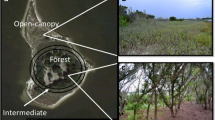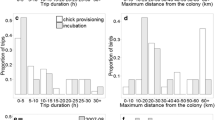Abstract
Although many animals deposit scent marks, previous studies have focused almost entirely on rodents or on the chemical structure of the signal. Here, we study the quantity and temporal pattern of chemical deposition by the territorial sagebrush lizard Sceloporus graciosus, measuring both femoral pore and fecal deposits. Specifically, we tested whether variation in deposition is a good cue of individual and sexual identity and/or whether it is more closely associated with body size and reproductive state, indicators of physiological condition. The results support the latter hypothesis. We found that although the amount of fluid deposited on a single perch (rarely quantified in mammals) carries little information on individual or sexual identity, it reflects the physiological condition and reproductive state of individual lizards and is replenished on a roughly weekly cycle, potentially providing additional information on the producer's activity level. The amount of deposition may thus provide important information to chemical receivers making mate choice and territorial defense decisions. The results further suggest that seasonal increases in gland production allow lizards to mark more sites rather than to influence the quality of the signal on a single perch.



Similar content being viewed by others
References
Alberts, A. C. 1993. Chemical and behavioral studies of femoral gland secretions in iguanid lizards. Brain Behav. Evol. 41:255–260.
Alberts, A. C., Pratt, N. C., and Phillips, J. A. 1992. Seasonal productivity of lizard femoral glands: relationship to social dominance and androgen levels. Physiol. Behav. 51:729–733.
Alberts, A. C., Phillips, J. A., and Werner, D. I. 1993. Sources of intraspecific variability in the protein composition of lizard femoral gland secretions. Copeia 1993:775–781.
Alberts, A. C., Jackintell, L. A., and Phillips, J. A. 1994. Effects of chemical and visual exposure to adults on growth, hormones, and behavior of juvenile green iguanas. Physiol. Behav. 55:987–992.
Aragón, P., López, P., and Martín, J. 2000. Size-dependent chemosensory responses to familiar and unfamiliar conspecific faecal pellets by the Iberian rock-lizard, Lacerta monticola. Ethology 106:1115–1128.
Aragón, P., López, P., and Martín, J. 2001. Chemosensory discrimination of familiar and unfamiliar conspecifics by lizards: Implication of field spatial relationships between males. Behav. Ecol. Sociobiol. 50:128–133.
Aragón, P., López, P., and Martín, J. 2003. Differential avoidance responses to chemical cues from familiar and unfamiliar conspecifics by male Iberian rock-lizards (Lacerta monticola). J. Herpetol. 37:583–585.
Bull, C. M. and Lindle, C. 2002. Following trails of partners in the monogamous lizard, Tiliqua rugosa. Acta Ethol. 5:25–28.
Cooper, W. E. Jr. and Habegger, J. J. 2000. Lingually mediated discrimination of prey, but not plant chemicals, by the Central American anguid lizard, Mesaspis moreletii. Amphib-reptil. 22:81–90.
Crews, D., Gill, C. J., and Wennstrom, K. L. 2004. Sexually dimorphic regulation of estrogen receptor a mRNA in the ventromedial hypothalamus of adult whiptail lizards is testosterone dependent. Brain Res. 1004:136–141.
Downes, S. J. 2002. Does responsiveness to predator scents affect lizard survivorship? Behav. Ecol. Sociobiol. 52:38–42.
Escobar, C. A., Labra, A., and Niemeyer, H. M. 2001. Chemical composition of precloacal secretions of Liolaemus lizards. J. Chem. Ecol. 27:1677–1690.
Ferkin, M. H., Lee, D. N., and Leonard, S. T. 2004. The reproductive state of female voles affects their scent marking behavior and the responses of male conspecifics to such marks. Ethology 110:257–272.
Halpern, M. 1992. Nasal chemical senses in reptiles: Structure and function, pp. 423–523, in C. Gans and D. Crews (eds.). Biology of the Reptilia, Vol. 18. University of Chicago Press, Chicago.
Hews, D. K. and Benard, M. F. 2001. Negative association between conspicuous visual display and chemosensory behavior in two Phrynosomatid lizards. Ethology 107:839–850.
Hews, D. K., Knapp, R., and Moore, M. C. 1994. Early exposure to androgens affects adult expression of alternative male types in tree lizards. Horm. Behav. 28:96–115.
Labra, A. and Niemeyer, H. M. 1999. Intraspecific chemical recognition in the lizard Liolaemus tenuis. J. Chem. Ecol. 25:1799–1811.
Labra, A., Beltran, S., and Niemeyer, H. M. 2001. Chemical exploratory behavior in the lizard Liolaemus bellii (Tropiduridae). J. Herpetol. 35:51–55.
Lindzey, J. and Crews, D. 1993. Effects of progesterone and dihydrotestosterone on stimulation of androgen-dependent sex behavior, accessory sex structures, and in vitro binding characteristics of cytosolic androgen receptors in male whiptail lizards (C. inornatus). Horm. Behav. 27:269–281.
López, P. and Martín, J. 2001. Pheromonal recognition of females takes precedence over the chromatic cue in male Iberian wall lizards, Podarcis hispanica. Ethology 107:901–912.
López, P. and Martín, J. 2002. Chemical rival recognition decreases aggression levels in male Iberian wall lizards, Podarcis hispanica. Behav. Ecol. Sociobiol. 51:461–465.
Martins, E. P. 1991. A field study of individual and sex differences in the push-up display of the sagebrush Lizard, Sceloporus graciosus. Anim. Behav. 41:403–416.
Martins, E. P. 1993. Contextual use of the push-up display by the sagebrush Lizard, Sceloporus graciosus. Anim. Behav. 45:25–36.
Mason, R. T. 1992. Reptilian pheromones, pp. 114–228, in C. Gans and D. Crews (eds.). Biology of the Reptilia, Vol. 18. University of Chicago Press, Chicago.
Mech, S. G., Dunlap, A. S., and Wolff, J. O. 2003. Female prairie voles do not choose males based on their frequency of scent marking. Behav. Proc. 61:101–108.
Molina-Borja, M., Padrón-Fumero, M., and Alfonso-Martín T. 1998. Morphological and behavioural traits affecting the intensity and outcome of male contests in Gallotia galloti galloti (Family Lacertidae). Ethology 104:314–322.
Nevison, C. M., Armstrong, S., Beynon, R. J., Humphries, R. E., and Hurst, J. L. 2003. The ownership signature in mouse scent marks is involatile. Proc. R. Soc. Lond., B Biol. Sci. 270:1957–1963.
SAS 2005. SAS/STAT software version 9.1. SAS Institute, Inc., Cary, NC.
Sheldahl, L. A. and Martins, E. P. 2000. Territorial behavior in the western fence lizard. Herpetol. 56:469–479.
Thompson, J. T. 2002. Complex traits: Multimodal behavior and convergent evolution. Ph.D. Dissertation, University of Oregon.
Wade, J., Huang, J.-M., and Crews, D. 1993. Hormonal control of sex differences in the brain, behavior and accessory sex structures of whiptail lizards (Cnemidophorus species). J. Neuroendocrinol. 5:81–93.
Wennstrom, K. L. and Crews, D. 1998. Effect of long-term castration and long-term androgen treatment on sexually dimorphic estrogen-inducible progesterone receptor mRNA levels in the ventromedial hypothalamus of whiptail lizards. Horm. Behav. 34:11–16.
Wolff, J. O., Mech, S. G., and Thomas, S. A. 2002. Scent marking in female prairie voles: A test of alternative hypotheses. Ethology 108:483–494.
Wyatt, T. D. 2003. Pheromones and Animal Behaviour. Cambridge University Press, Cambridge.
Zuri, I. and Bull, C. M. 2000. Reduced access to olfactory cues and home-range maintenance in the sleepy lizard (Tiliqua rugosa). J. Zool. Lond. 252:137–145.
Acknowledgments
We thank Yoni Brandt, Heather Bleakley, and Erin Kelso for help in collecting lizards in the field, Erin French and Heather Bleakley for methodological development, Sarah Davenport and Erin Kelso for lizard care, and Barbara Clucas, Jessica Stapley, and two anonymous reviewers for comments on a previous version of the manuscript. This research was supported by funds from the US National Science Foundation (DMS 0306243 to EAH).
Author information
Authors and Affiliations
Corresponding author
Rights and permissions
About this article
Cite this article
Martins, E.P., Ord, T.J., Slaven, J. et al. Individual, Sexual, Seasonal, and Temporal Variation in the Amount of Sagebrush Lizard Scent Marks. J Chem Ecol 32, 881–893 (2006). https://doi.org/10.1007/s10886-006-9029-8
Received:
Revised:
Accepted:
Published:
Issue Date:
DOI: https://doi.org/10.1007/s10886-006-9029-8




